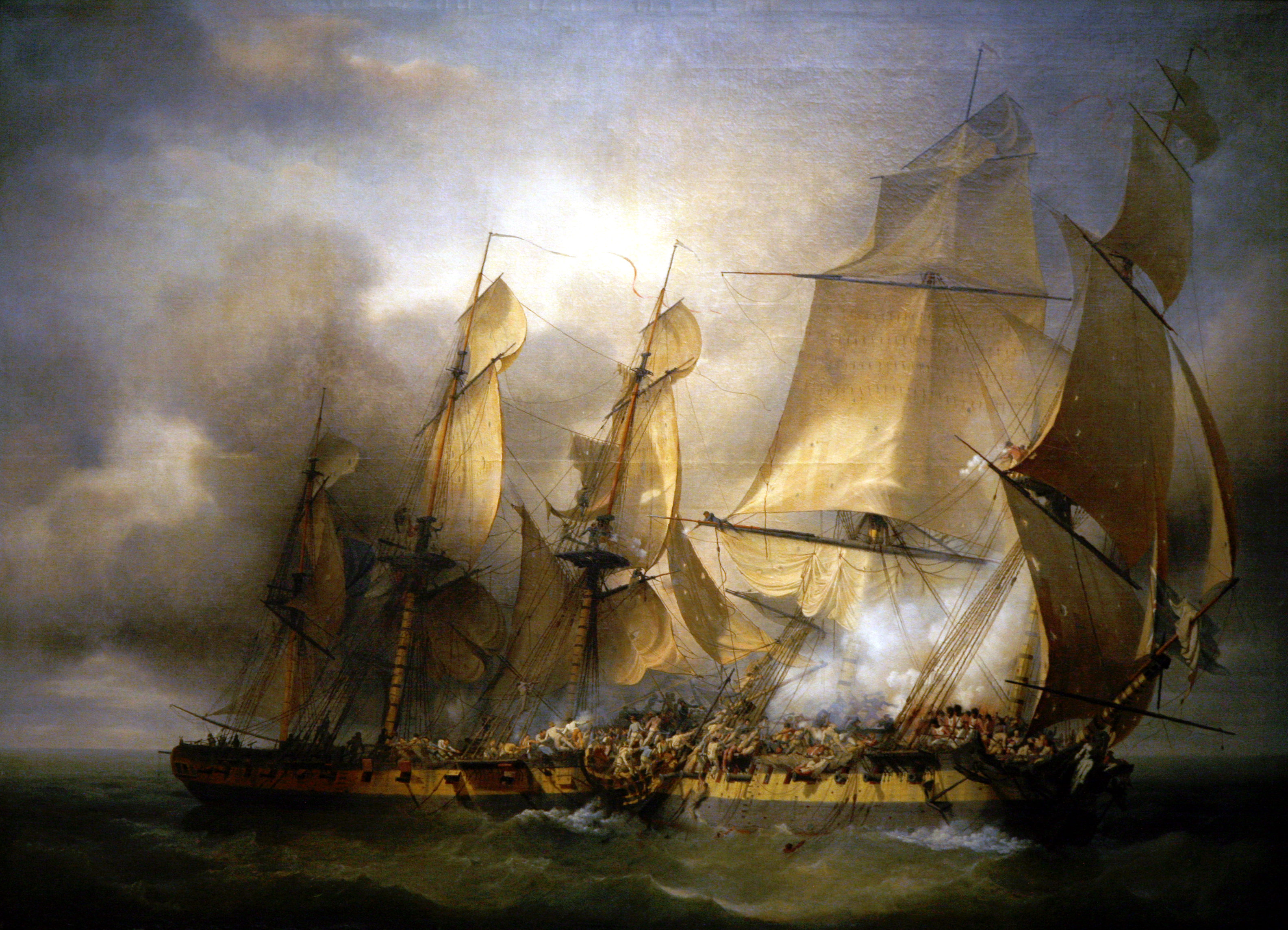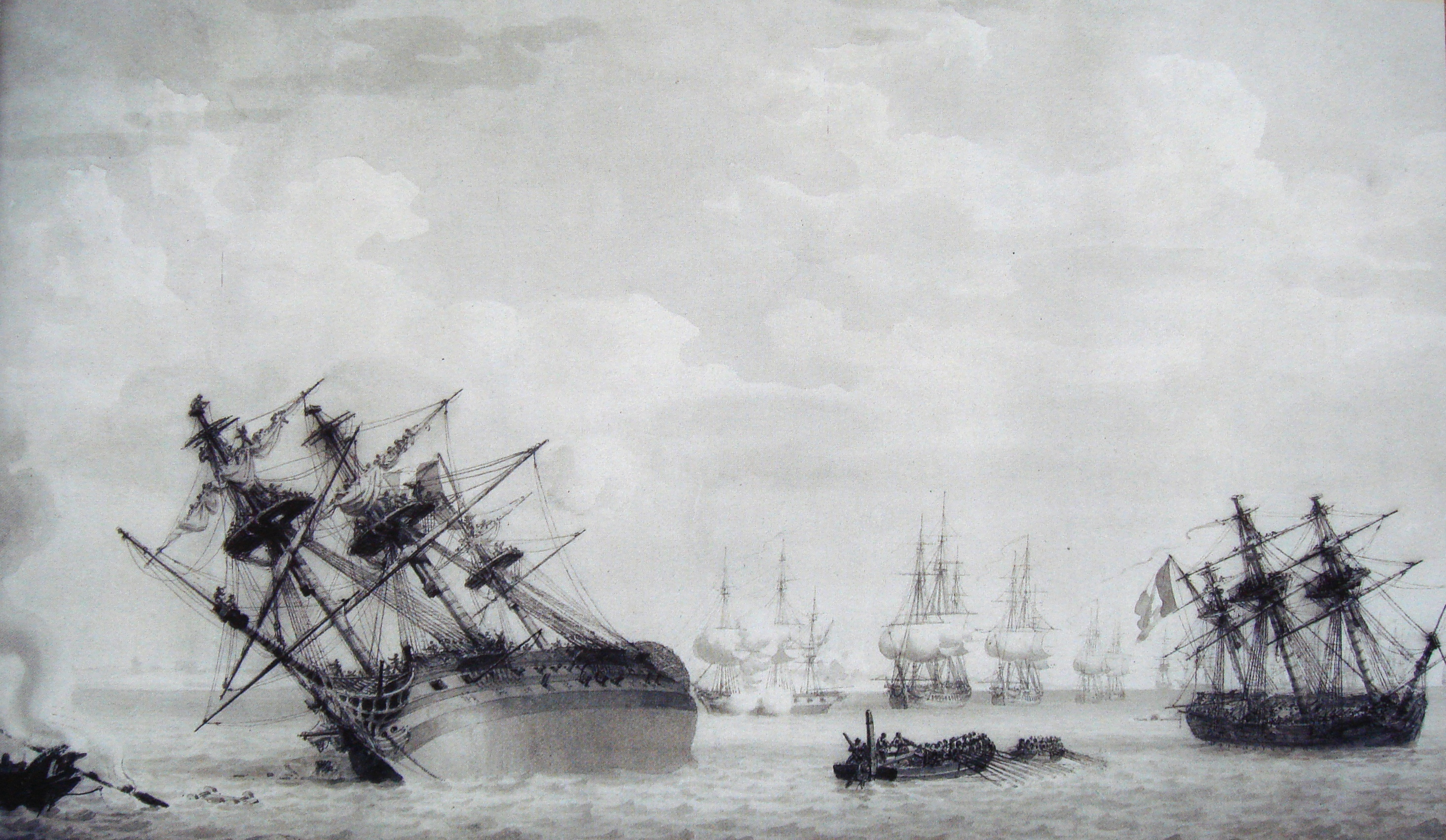|
French Ship Régulus (1805)
''Régulus'' was a 74-gun List of ships of the line of France, ship of the line of the French Navy. From 25 May 1801, her armament was upgraded to between 80 and 86 guns. During the Atlantic campaign of 1806, she was the flagship of Jean-Marthe-Adrien L'Hermite, L'Hermite's squadron (also comprising frigates and and corvette ) during L'Hermite's expedition. She patrolled from the Gulf of Guinea to Brazil and the Caribbean. On 6 January 1806 the French squadron captured the 16-gun sloop-of-war . The squadron also captured about 20 merchantman, notably including the ships and ''Plowers'' (). In 1808, ''Régulus'' was in station with the Brest squadron. In 1809, she was transferred to Rochefort. She famously took part in the Battle of the Basque Roads from 11 April 1809, under Captain Jean Jacques Étienne Lucas, Lucas, where she ran aground between Les Palles and Fouras. For 17 days, the stranded ship repelled assaults by the British, before refloating and returning to Roch ... [...More Info...] [...Related Items...] OR: [Wikipedia] [Google] [Baidu] |
Louis-Philippe Crépin
Louis-Philippe Crépin (1772, Paris – 26 November 1851, Paris) was a French marine painter. Together with Théodore Gudin, he was appointed as one of France's first two Peintres de la Marine in 1830.Ministère de l'instruction publique et des beaux-arts; ''Réunion des sociétés des beaux-arts des départements'', vol.27e, 1903, Noémi-Noire Oursel, editoOnline/ref> Biography He studied marine painting with Joseph Vernet and landscapes with Hubert Robert. Before that, he had been a sailor with four years of experience as a helmsman and (a seaman in charge of the sails). He had his first exhibit at the Paris in 1796 with "La sortie du port de Brest". He would hold showings there intermittently until 1835. As early as 1817, he received a letter from the "Ministre de la Marine et des Colonies", Laurent de Gouvion Saint-Cyr, giving him a twenty-year commission to create marine paintings for the government; especially the Ministère de la Marine, where he set up a workshop. T ... [...More Info...] [...Related Items...] OR: [Wikipedia] [Google] [Baidu] |
L'Hermite's Expedition
L'Hermite's expedition was a French naval operation launched in 1805 during the Napoleonic Wars. The operation was intended as both a commerce raiding operation against the British trading posts of West Africa and as a diversion to the Trafalgar campaign. Sailing from Lorient in October 1805 with one ship of the line, two frigates and a corvette, Commodore Jean-Marthe-Adrien L'Hermite was under orders to intercept and destroy British traders and slave ships off the West African coast and await reinforcements under Jérôme Bonaparte which were to be used in the invasion and capture of one of the British trading forts for use as a permanent French naval base from which further raiding operations could be conducted. It was also hoped by the French naval command that L'Hermite might draw some of the large British fleet maintained off Cadiz away from the blockade to allow the French and Spanish allied fleet trapped in the harbour to escape. Although L'Hermite achieved minor successes ... [...More Info...] [...Related Items...] OR: [Wikipedia] [Google] [Baidu] |
Ship Fires
A ship is a large watercraft that travels the world's oceans and other sufficiently deep waterways, carrying cargo or passengers, or in support of specialized missions, such as defense, research, and fishing. Ships are generally distinguished from boats, based on size, shape, load capacity, and purpose. Ships have supported exploration, trade, warfare, migration, colonization, and science. After the 15th century, new crops that had come from and to the Americas via the European seafarers significantly contributed to world population growth. Ship transport is responsible for the largest portion of world commerce. The word ''ship'' has meant, depending on the era and the context, either just a large vessel or specifically a ship-rigged sailing ship with three or more masts, each of which is square-rigged. As of 2016, there were more than 49,000 merchant ships, totaling almost 1.8 billion dead weight tons. Of these 28% were oil tankers, 43% were bulk carriers, and 13% were con ... [...More Info...] [...Related Items...] OR: [Wikipedia] [Google] [Baidu] |
Maritime Incidents In 1814
Maritime may refer to: Geography * Maritime Alps, a mountain range in the southwestern part of the Alps * Maritime Region, a region in Togo * Maritime Southeast Asia * The Maritimes, the Canadian provinces of Nova Scotia, New Brunswick, and Prince Edward Island * Maritime County, former county of Poland, existing from 1927 to 1939, and from 1945 to 1951 * Neustadt District, Reichsgau Danzig-West Prussia, known from 1939 to 1942 as ''Maritime District'', a former district of Reichsgau Danzig-West Prussia, Nazi Germany, from 1939 to 1945 * The Maritime Republics, thalassocratic city-states on the Italian peninsula during the Middle Ages Museums * Maritime Museum (Belize) * Maritime Museum (Macau), China * Maritime Museum (Malaysia) * Maritime Museum (Stockholm), Sweden Music * ''Maritime'' (album), a 2005 album by Minotaur Shock * Maritime (band), an American indie pop group * "The Maritimes" (song), a song on the 2005 album ''Boy-Cott-In the Industry'' by Classified * "Maritime ... [...More Info...] [...Related Items...] OR: [Wikipedia] [Google] [Baidu] |
Maritime Incidents In 1809
Maritime may refer to: Geography * Maritime Alps, a mountain range in the southwestern part of the Alps * Maritime Region, a region in Togo * Maritime Southeast Asia * The Maritimes, the Canadian provinces of Nova Scotia, New Brunswick, and Prince Edward Island * Maritime County, former county of Poland, existing from 1927 to 1939, and from 1945 to 1951 * Neustadt District, Reichsgau Danzig-West Prussia, known from 1939 to 1942 as ''Maritime District'', a former district of Reichsgau Danzig-West Prussia, Nazi Germany, from 1939 to 1945 * The Maritime Republics, thalassocratic city-states on the Italian peninsula during the Middle Ages Museums * Maritime Museum (Belize) * Maritime Museum (Macau), China * Maritime Museum (Malaysia) * Maritime Museum (Stockholm), Sweden Music * ''Maritime'' (album), a 2005 album by Minotaur Shock * Maritime (band), an American indie pop group * "The Maritimes" (song), a song on the 2005 album ''Boy-Cott-In the Industry'' by Classified * "Marit ... [...More Info...] [...Related Items...] OR: [Wikipedia] [Google] [Baidu] |
1805 Ships
Eighteen or 18 may refer to: * 18 (number), the natural number following 17 and preceding 19 * one of the years 18 BC, AD 18, 1918, 2018 Film, television and entertainment * ''18'' (film), a 1993 Taiwanese experimental film based on the short story ''God's Dice'' * ''Eighteen'' (film), a 2005 Canadian dramatic feature film * 18 (British Board of Film Classification), a film rating in the United Kingdom, also used in Ireland by the Irish Film Classification Office * 18 (''Dragon Ball''), a character in the ''Dragon Ball'' franchise * "Eighteen", a 2006 episode of the animated television series ''12 oz. Mouse'' Music Albums * ''18'' (Moby album), 2002 * ''18'' (Nana Kitade album), 2005 * '' 18...'', 2009 debut album by G.E.M. Songs * "18" (5 Seconds of Summer song), from their 2014 eponymous debut album * "18" (One Direction song), from their 2014 studio album ''Four'' * "18", by Anarbor from their 2013 studio album ''Burnout'' * "I'm Eighteen", by Alice Cooper commonly re ... [...More Info...] [...Related Items...] OR: [Wikipedia] [Google] [Baidu] |
Ships Of The Line Of The French Navy
A ship is a large watercraft that travels the world's oceans and other sufficiently deep waterways, carrying cargo or passengers, or in support of specialized missions, such as defense, research, and fishing. Ships are generally distinguished from boats, based on size, shape, load capacity, and purpose. Ships have supported exploration, trade, warfare, migration, colonization, and science. After the 15th century, new crops that had come from and to the Americas via the European seafarers significantly contributed to world population growth. Ship transport is responsible for the largest portion of world commerce. The word ''ship'' has meant, depending on the era and the context, either just a large vessel or specifically a ship-rigged sailing ship with three or more masts, each of which is square-rigged. As of 2016, there were more than 49,000 merchant ships, totaling almost 1.8 billion dead weight tons. Of these 28% were oil tankers, 43% were bulk carriers, and 13% were co ... [...More Info...] [...Related Items...] OR: [Wikipedia] [Google] [Baidu] |
Meschers-sur-Gironde
Meschers-sur-Gironde (, literally ''Meschers on Gironde'') is a commune in the Charente-Maritime department in southwestern France. Population See also * Communes of the Charente-Maritime department The following is a list of the 463 communes of the Charente-Maritime department of France. The communes cooperate in the following intercommunalities (as of 2020):Communes of Charente-Maritime Charente-Maritime communes articles needing translation from French Wikiped ... [...More Info...] [...Related Items...] OR: [Wikipedia] [Google] [Baidu] |
Jean Jacques Étienne Lucas
Jean Jacques Étienne Lucas (28 April 1764 – 6 November 1819) was a French Navy officer, famous for his role in the Battle of Trafalgar. Career Born in Marennes, he joined the French Navy at the age of 14. From 1779 to 1782 he sailed on the . During this period, he fought at the battle off Cape Breton (21 July 1781), part of the American Revolutionary War. The Battle of Trafalgar He is primarily remembered for his role in the Battle of Trafalgar. By 1805, Lucas was a ''capitaine de vaisseau'', the French title for captain. He commanded the French ship of the line . On 21 October 1805, at Trafalgar, ''Redoutable'' was located just off the port side of the , flagship of Admiral Pierre-Charles Villeneuve. As a result of this positioning, Lucas and his crew found themselves between the two columns of British ships commanded by Nelson and in the heat of battle from very early on in the conflict. They engaged , Nelson's flagship, and through use of heavy artillery they came ast ... [...More Info...] [...Related Items...] OR: [Wikipedia] [Google] [Baidu] |
Battle Of The Basque Roads
The Battle of the Basque Roads, also known as the Battle of Aix Roads ( French: ''Bataille de l'île d'Aix'', also ''Affaire des brûlots'', rarely ''Bataille de la rade des Basques''), was a major naval battle of the Napoleonic Wars, fought in the narrow Basque Roads at the mouth of the Charente River on the Biscay coast of France. The battle, which lasted from 11–24 April 1809, was unusual in that it pitted a hastily-assembled squadron of small and unorthodox British Royal Navy warships against the main strength of the French Atlantic Fleet, the circumstances dictated by the cramped, shallow coastal waters in which the battle was fought. The battle is also notorious for its controversial political aftermath in both Britain and France. In February 1809 the French Atlantic Fleet, blockaded in Brest on the Breton coast by the British Channel Fleet, attempted to break out into the Atlantic and reinforce the garrison of Martinique. Sighted and chased by British blockade squadrons, ... [...More Info...] [...Related Items...] OR: [Wikipedia] [Google] [Baidu] |



